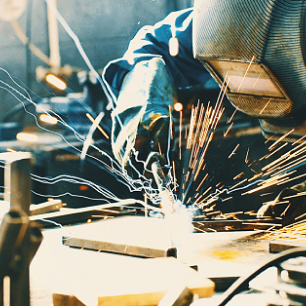Jump to:
Up Close with the AWS D14 Committee
Members of the AWS D14 Committee on Machinery and Equipment recently came together to discuss the committee’s beginnings; the newly released D14.0/D14.0M:2024, Machinery and Equipment Welding Specification; why shops should switch from using AWS D1.1, Structural Welding Code — Steel, and other codes to D14.0; and more.
History and Purpose
Note: The following text, provided by D14 Vice Chair Bernard Banzhaf, is an excerpt of Tom Landon’s Editorial “It Pays to Get Involved” from the September 2013 Welding Journal.
The D14 Committee was organized in 1967 to provide standards and recommended practices for the control of welding fabrication on various types of industrial machinery and equipment. The committee’s goal was to collect, review, and promulgate minimum requirements for the control of welding, including design data, process selection, material control, fabrication practices, quality standards, and inspection and testing programs. After initial discussions, it became evident that a universal standard covering all machinery and equipment was impractical due to differences in utilization and operational requirements. The solution at the time was to form several subcommittees to address a specific type or class of equipment and its unique welding requirements.
Over the years, the D14 standards have evolved, but the committee’s purpose and goal have remained the same. At one time, at least six subcommittees were responsible for standards that addressed six different types of equipment.
These standards and their areas of interest were as follows:
• D14.1, Specification for Welding of Industrial and Mill Cranes and Other Material Handling Equipment, addressed cranes for industrial, mill, powerhouse, and nuclear facilities as well as overhead material-handling equipment.
• D14.3, Specification for Welding Earthmoving, Construction, and Agricultural Equipment, addressed self-propelled, on- and off-highway crawlers, tractors, graders, loaders, off-highway trucks, power shovels, backhoes, and the like.
• D14.5, Specification for Welding Presses and Press Components, addresses weld joint design and fabrication of presses and press components.
• D14.6, Specification for Welding Rotating Elements of Equipment, covers the manufacture of rotating equipment components such as fans, pumps, compressors, etc.
• D14.7, Recommended Practice for Surfacing and Reconditioning of Industrial Mill Rolls, provides guidance for preparing, building up, cladding, heat treating, finish machining, and inspecting new and reconditioned industrial mill rolls.
• D14.9, Specification for the Welding of Hydraulic Cylinders, addresses the design and manufacture of welded joints in hydraulic cylinders.
In addition, a D14 subcommittee published D14.4, Specification for the Design of Welded Joints in Machinery and Equipment, which established requirements for allowable stresses and other design criteria.
The D14 Committee and subcommittees have worked diligently to maintain the relevance of their suite of standards and have incorporated new technologies as they have become available to industry.
The New D14.0 Specification
AWS D14.0 establishes the design, manufacture, quality, inspection, and repair requirements for carbon, low-alloy, and alloy steel welded connections in machinery and equipment. This document combines and replaces AWS D14.1, D14.3, D14.4/D14.4M, Specification for the Design of Welded Joints in Machinery and Equipment, and D14.5. It addresses these topics: weld joint design, workmanship, quality acceptance criteria, nondestructive examination (NDE) methods (visual, radiographic, ultrasonic, magnetic particle, and liquid penetrant), repair of weld defects, and postweld heat treatment. Overall, the page count is 238, including covers. In addition, the D14 Committee dedicated this edition to the late David Landon for his significant contribution to welding.
Design – Inspection – Acceptance Criteria Approach
According to Richard L. Holdren, AWS vice president, a member of the D14 Committee, and an adviser to the D14G Subcommittee on Welding of Rotating Equipment, a major benefit of D14.0 is that the designer specifies a specific joint detail based on the expected fatigue conditions. Once that selection is made, a specific inspection class is assigned. This approach has been the primary basis for AWS D14.4.
In D14.0, four inspection classes are identified as I, II, III, and IV, with Class I representing the most severe fatigue conditions. The higher the class number, the lower the fatigue conditions, with Class IV being static. Once the inspection class is known, Table 11.1, NDE and Visual Inspection Requirements, specifies the appropriate NDE and visual inspection methods to be applied to a weld of a specific inspection class. The type of inspection is dictated by the severity of the fatigue loading. Continuing this trend, Table 11.2, Visual Acceptance Criteria, provides the acceptance criteria for visual weld inspection. Using this approach, the designer, in essence, assigns the degree of inspection and the appropriate acceptance criteria based on the expected service.
Certification
To further highlight this new AWS welding standard, Holdren shared that plans are underway to develop a Certified Welding Inspector (CWI) endorsement examination based on D14.0. Consideration is also given for its use in other AWS certification offerings, including as part of the next-generation AWS Certified Welding Engineer (CWEng) examination.
Considerations for Switching from Using D1.1 and Other Codes to D14.0
Duane Miller, a D14 and D1 committee member, feels there are several reasons why a producer of machinery should use AWS D14.0 instead of D1.1. The top three reasons are as follows.
Reason 1. AWS D1.1 was written with the assumption that a building code is involved. For example, consider this definition from D1.1: “The term building code, whenever the expression occurs in this code, refers to the building law or specification or other construction regulations in conjunction with which this code is applied. In the absence of any locally applicable building law or specifications or other construction regulations, it is recommended that construction comply with the Specification for the Design, Fabrication, and Erection of Structural Steel for Buildings of the American Institute of Steel Construction (AISC).”
The linkage of AWS D1.1 to building codes inherently connects D1.1 to “any locally applicable building law” and recommends compliance with AISC steel specifications. Obviously, the design and fabrication of machinery are not subject to building codes, and most machinery is not designed and constructed in accordance with AISC requirements.
In contrast, the scope of D14.0 states the following: “This specification establishes design, manufacture, quality, inspection, and repair requirements for welded connections in machinery and equipment . . . It reflects the welding practices employed by manufacturers within the industry and incorporates various methods which have been employed by manufacturers within the industry and incorporates various methods which have been proven successful by individual manufacturers.”
D14.0 does not reference building codes, AISC specifications, or other building-related concepts but focuses on the practices used in the machinery and equipment industries.
Reason 2. AWS D1.1 provides a distinct and necessary differentiation between the engineer and the contractor. The engineer in D1.1 is not defined in terms of education or licensure but rather in terms of the relationship with the building owner, as follows: “Engineer: A duly designated individual who acts for and in behalf of the Owner on all matters within the scope of the code.”
Consistent with building codes, the engineer is the individual with legal responsibility for the integrity of the structure being designed and built. Accordingly, D1.1 assigns this individual the authority to make certain decisions; the engineer is responsible for the consequences of such decisions.
Throughout D1.1, there are references that cite the need for the engineer’s approval. For an equipment manufacturer to follow D1.1 to the letter, a provision that requires the engineer’s approval would require contact with the owner or their representative. Two implications follow: First, for standard machinery that is made and put into inventory, the owner is unknown when such decisions are required to be made. Second, most machinery and equipment owners are not equipped to make the technical decisions assigned to the engineer by D1.1.
D14.0 uses a different approach, defining three terms as follows:
“Design Authority. The individual or organization responsible for all decisions and specifications with respect to the design of the equipment and/or subcomponents.
Manufacturing Authority. The individual or organization responsible for all decisions and specifications with respect to the manufacturing of the equipment and/or subcomponents.
Inspection Authority. The individual or organization responsible for all decisions and specifications with respect to the inspection requirements of the equipment and/or subcomponents.”
Absent from these generic definitions is any reference to the owner. In some cases, the owner may be the design authority. In other cases, the machinery or equipment manufacturer may be the design authority. D14.0 provides flexibility in this regard, as detailed in Table 1.1, Examples of Typical Division of Responsibilities, which provides sufficient flexibility to be adapted to any situation involving machinery and equipment.
Reason 3. AWS D1.1 provides for the use of steels suitable for structures. The D1 Committee on Structural Welding considers factors such as the steel composition and control of mechanical properties when the steel is listed in D1.1. Equipment and machinery manufacturers have successfully used American Iron and Steel Institute (AISI)/Society of Automotive Engineers (SAE) grades of steel, even though the material specification does not have prescribed mechanical properties. While AISI/SAE 1030, for example, is not listed in D1.1, it is included in D14.0. Additionally, for manufacturers that utilize non-U.S. steel specifications, D14.0 lists EN and GB/T steels. Because base metals are often sourced locally, the inclusion of non-U.S. steel specifications makes D14.0 easier to use in overseas operations.
Join the Committee
Through their time and knowledge, committee volunteers allow AWS to continuously advance the science, technology, and application of welding and allied joining and cutting processes. With the new D14.0 document covering so many types of industrial equipment, its user base is huge, which is why D14 Chair Joe Bailey encourages industry to join the committee.
“If your company owns a fleet of trailers, stump grinders, skid loaders, excavators, or agricultural tractors, you should care about the quality of welding going into producing this equipment. Join the D14 Committee to learn what is going on, promote use of this standard, and protect your company’s interest in maintaining quality equipment. If you are part of an original equipment manufacturer (OEM) of industrial, agricultural, or even factory equipment, this standard is for you. If you are a supplier to OEMs, of subcomponents for factory equipment for welding, inspection, or testing, becoming a member of D14 is a great way to ensure that you are meeting the requirements for the industry,” he shared.
Bailey also stressed that joining an AWS committee is a great way to grow your network and career. The D14 Committee is a mix of younger professionals and seasoned veterans from various companies.
“We learn so much from each other and frequently share best practices,” he said. “There is a place for all different types of skill sets in D14. We have task groups on training and qualification, weldment design, fabrication, quality and nondestructive examination, and more.”
Future Thoughts
The D14 Committee may have just released its newest standard, but it is already working on the next one, which is why it needs volunteer members representing the following segments of the industry: users, educators, and general interest.
“We are excited for the launch of this new standard, the new content it contains, and the opportunities for broader industry adoption,” Bailey added. “In keeping with our relentless pursuit of improvement, those of us on the D14 Committee have already turned our attention to the next edition of D14.0. We are continuing to make incremental improvements to this document.”
If you’d like to join the D14 Committee, contact Program Manager Kevin Bulger at kbulger@aws.org.
This article was written by KRISTIN CAMPBELL (managing editor of the Welding Journal) for the American Welding Society.


